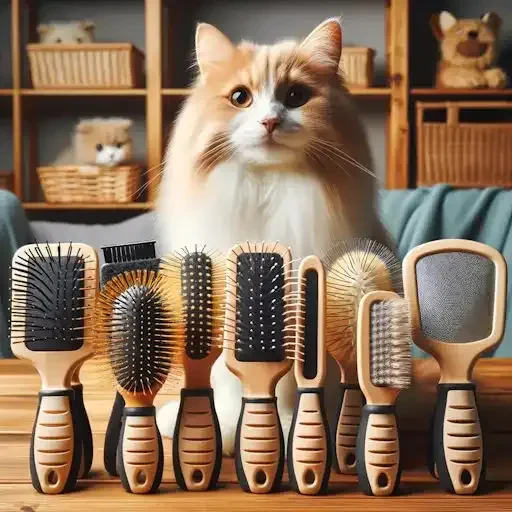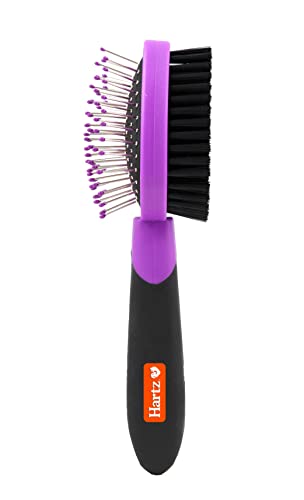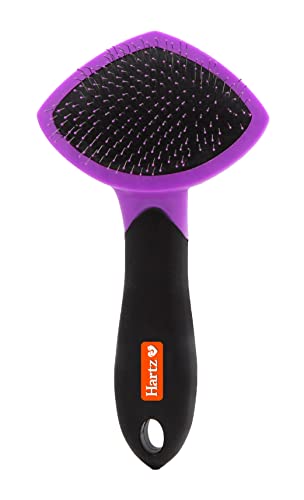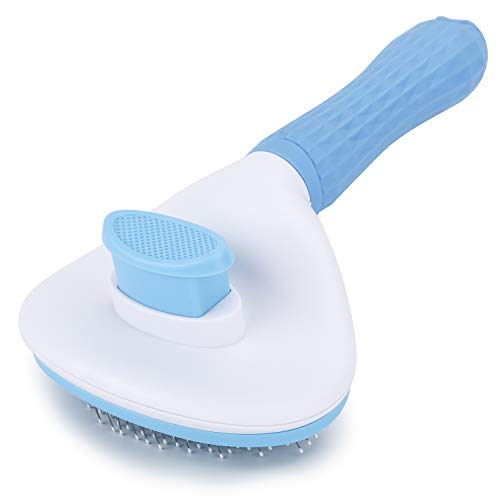Are you tired of finding tumbleweeds of cat fur drifting across your floors? Do you wince at the sight of mats clinging to your long-haired feline's coat? Or perhaps you're just beginning your journey as a cat owner and want to start on the right paw when it comes to care. No matter your experience level, understanding the importance of cat grooming and equipping yourself with the right supplies is absolutely essential. More than just maintaining a pristine appearance, regular grooming is a cornerstone of your cat's health and overall well-being. It's an act of care that extends far beyond aesthetics, touching upon their physical comfort, their emotional security, and even the strength of the bond you share. This article will guide you through the world of essential cat grooming supplies, revealing why they are indispensable for every cat owner and equipping you with the knowledge to build a comprehensive toolkit that will keep your feline companion looking and feeling their absolute best.
Grooming your cat is far more than a superficial exercise in vanity; it’s a vital component of responsible cat ownership, interwoven with numerous health benefits that contribute to a long and happy life for your feline friend. One of the most immediate and noticeable benefits of regular grooming, particularly brushing, is the significant reduction in hairballs. Cats are meticulous groomers themselves, and as they lick their fur, they inevitably ingest loose hairs. While their digestive systems are designed to process some hair, excessive amounts can clump together in the stomach, forming hairballs that are then unceremoniously expelled. Regular brushing removes a substantial amount of this loose fur before your cat has a chance to ingest it, drastically minimizing the formation of hairballs and the unpleasant (for both of you!) experience of dealing with them.
Beyond hairball control, grooming plays a crucial role in maintaining healthy skin and coat. Brushing acts as a gentle massage for your cat’s skin, stimulating blood circulation. This improved circulation helps to nourish hair follicles and promote healthy hair growth, resulting in a vibrant and lustrous coat. Furthermore, brushing distributes the natural oils produced by your cat’s skin evenly across their fur. These natural oils are essential for keeping the coat moisturized, preventing dryness, and maintaining a healthy sheen. Regular grooming also removes dirt, debris, and external parasites that can accumulate in your cat's fur. Dust, pollen, and environmental pollutants can irritate the skin and dull the coat's shine. By removing these irritants, grooming helps keep the skin clean and healthy, allowing your cat's natural beauty to shine through.
Perhaps one of the most often overlooked, yet profoundly important, benefits of regular grooming is the opportunity it provides for early detection of potential health issues. As you gently brush and handle your cat, you become intimately familiar with their body. This regular close contact allows you to notice any subtle changes that might indicate an underlying health problem. During grooming sessions, you can palpate for lumps, bumps, or unusual swellings that could be indicative of tumors, cysts, or abscesses. You can observe their skin for any changes in texture, color, or the presence of rashes, lesions, or areas of irritation. You can also check for external parasites like fleas and ticks, or signs of flea dirt. Early detection of such issues is crucial for timely veterinary intervention and can significantly improve treatment outcomes. Grooming sessions become a valuable “health check” opportunity, allowing you to proactively monitor your cat's well-being and address potential problems before they escalate.
For owners of long-haired cats, regular grooming is not just beneficial, it’s absolutely essential to prevent the formation of mats and tangles. Long, luxurious coats are prone to tangling, especially if not regularly maintained. Mats are dense clumps of matted fur that can become incredibly painful for your cat. They pull on the skin, restricting movement, trapping moisture and debris, and creating an ideal environment for skin infections. Removing severe mats often requires professional grooming or even veterinary intervention. However, with consistent and thorough brushing, particularly with the right tools, you can effectively prevent mats and tangles from forming in the first place, ensuring your long-haired beauty remains comfortable and pain-free.
Beyond the purely physical health benefits, grooming offers a profound opportunity for bonding and strengthening the relationship you share with your cat. For many cats, grooming, when introduced correctly and performed gently, can be a deeply pleasurable and bonding experience. It mimics the social grooming that cats engage in with each other, a sign of affection and trust within their feline social groups. By grooming your cat, you are essentially participating in this social behavior, sending a powerful message of care and affection. Regular grooming sessions create dedicated time for focused interaction between you and your cat. It’s a moment where distractions are minimized, and you are entirely focused on them. This focused attention is incredibly valuable in building trust and deepening your bond. For cats who may be initially hesitant about being handled, gentle and positive grooming sessions can be instrumental in building trust and comfort. Starting slowly, using positive reinforcement with treats and praise, and respecting your cat's boundaries can gradually transform grooming from a potentially stressful event into a positive and anticipated ritual, fostering a stronger and more loving connection.
Finally, and simply put, regular grooming contributes significantly to your cat’s overall comfort and hygiene. Just as we feel refreshed and cleaner after a shower or brushing our hair, cats also benefit from the feeling of being well-groomed. Removing loose fur that might be itchy or irritating, eliminating debris that can weigh down their coat, and keeping their nails trimmed to a comfortable length all contribute to their physical comfort. Furthermore, maintaining good dental hygiene is crucial for your cat's overall health and comfort. Dental disease is incredibly common in cats and can lead to pain, tooth loss, and systemic health problems. Regular dental care, even simple tooth brushing or the use of dental wipes, can significantly improve their oral hygiene, preventing bad breath and contributing to a healthier and more comfortable mouth. By addressing these aspects of hygiene through regular grooming, you are ensuring your cat feels their best, both physically and emotionally, allowing them to live a happier and more comfortable life.
To unlock the myriad benefits of cat grooming, you need the right tools for the job. Building an essential grooming toolkit is an investment in your cat’s health and well-being. Let’s explore the must-have supplies that should be in every cat owner’s grooming arsenal. When it comes to brushes and combs, variety is key, as different tools are designed for different coat types and purposes. The slicker brush is a grooming staple, recognizable by its fine, short wire bristles that are angled for effective detangling and loose fur removal. Slicker brushes are versatile and suitable for most coat types, particularly medium to long-haired cats. They excel at gently working through tangles and lifting away loose undercoat and surface fur. However, it's important to use a slicker brush with a gentle hand, as the wire bristles can irritate the skin if applied too aggressively. Always brush in the direction of hair growth and avoid pressing too hard.
For smoothing the coat and distributing those beneficial natural oils, the bristle brush is an excellent choice. Bristle brushes typically feature natural or synthetic bristles that are softer and more closely packed than slicker brush bristles. They are ideal for finishing touches after using a slicker or deshedding tool, leaving the coat smooth and polished. Bristle brushes are also particularly well-suited for short-haired cats, where their primary purpose is to enhance shine and remove surface debris.
For cats who are sensitive to traditional brushes or for quick daily grooming sessions, a grooming glove or mitt can be a fantastic option. These gloves or mitts are equipped with rubber or silicone tips or nubs on the palm and fingers. As you pet your cat with the glove, the nubs gently massage the coat and collect loose fur. Grooming gloves are especially effective for short-haired cats and can be a less intimidating introduction to grooming for cats who are hesitant about brushes. They are also convenient for collecting loose fur during regular petting sessions, minimizing shedding around your home.
To tackle mats and tangles head-on, and for meticulous flea and debris checks, a metal comb is indispensable. Metal combs come in both wide-toothed and fine-toothed varieties. A wide-toothed comb is your first line of defense against tangles and mild mats. The wider spacing between the teeth allows you to gently work through knots without pulling or causing discomfort. Always start with a wide-toothed comb to detangle before moving on to other tools. A fine-toothed comb, with its closely spaced teeth, is perfect for finishing work, removing fine debris, and, importantly, for checking for fleas and flea dirt. Flea dirt, the fecal matter of fleas, appears as tiny black specks that are often easier to spot with a fine-toothed comb.
While not strictly essential for all cats, a deshedding tool is a highly recommended addition to your toolkit, especially if you live with a double-coated breed or struggle with excessive shedding. Deshedding tools, often featuring a blade or comb-like design with specialized teeth, are engineered to efficiently remove loose undercoat fur. The undercoat is the dense, fluffy layer beneath the topcoat that is often the primary source of shedding. Deshedding tools can dramatically reduce shedding by removing this undercoat fur before it has a chance to fall out around your home. However, caution is advised with deshedding tools. Overuse or aggressive application can irritate the skin. Use deshedding tools sparingly, following the manufacturer's instructions, and avoid pressing too hard.
Moving beyond brushing, nail care is another crucial aspect of cat grooming, and for this, you will need nail clippers. There are two primary types of cat nail clippers: scissor-type and guillotine-type. Scissor-type clippers resemble small scissors with curved blades specifically designed for trimming nails. They are generally user-friendly, offering good control and precision, making them a good choice for beginners and suitable for most nail sizes. Guillotine-type clippers feature a blade that slides down to clip the nail when the handles are squeezed. They tend to be more powerful and are particularly effective for thicker nails. However, they may require a bit more practice to use safely and accurately. Regardless of the clipper type you choose, it is absolutely essential to have styptic powder on hand. Styptic powder is a powder specifically designed to stop bleeding quickly. Accidentally clipping the quick, the pink part of the nail containing blood vessels and nerves, is a common mishap, especially for beginners. Having styptic powder readily available allows you to quickly and effectively stop any bleeding should this occur, minimizing discomfort for your cat and preventing infection.
While cats are famously self-cleaning, occasional baths are sometimes necessary. When bathing becomes required, be sure to use cat-specific shampoo. This is paramount. A cat’s skin has a different pH balance than human skin, and human shampoos or even dog shampoos can be too harsh and drying for feline skin, leading to irritation and discomfort. Cat-specific shampoos are formulated to be pH-balanced for feline skin and are typically gentler. There are also various specialized cat shampoos available to address specific needs, such as hypoallergenic shampoos for sensitive skin, oatmeal shampoos for soothing itchy skin, and flea shampoos (though flea treatment is generally best addressed with dedicated flea prevention products). After a bath, gentle drying is key. Use soft, absorbent towels, and microfiber towels are particularly recommended as they are quick-drying and gentle on the coat. For long-haired cats, a cat-specific conditioner can be beneficial after bathing. Conditioner helps to detangle the coat, making it easier to brush and manage, and adds moisture back into the fur, preventing dryness. Again, ensure you use a conditioner specifically formulated for cats.
Dental care is a critical component of overall cat health, and incorporating dental hygiene into your grooming routine is vital. You will need a cat toothbrush and toothpaste specifically formulated for cats. Never use human toothpaste on cats, as it contains fluoride and other ingredients that are toxic to them. Cat toothpaste is designed to be palatable to cats, often flavored with chicken or fish, and does not contain harmful ingredients. Cat toothbrushes are smaller and softer than human toothbrushes, designed to comfortably fit into a cat’s mouth. For cats who absolutely resist toothbrushing, dental wipes can be a less effective but still helpful alternative. Dental wipes are pre-moistened wipes that you can gently rub over your cat's teeth and gums to remove plaque and debris. While not as thorough as brushing, they can still contribute to oral hygiene, especially when combined with dental treats and chews. Dental treats and chews are supplementary tools that can help maintain dental health by mechanically cleaning teeth as your cat chews. They are not a replacement for regular brushing or dental wipes but can be a helpful addition to a comprehensive dental care routine.
For routine ear cleaning, especially if your cat is prone to earwax buildup or ear infections, you will need a cat-specific ear cleaning solution. Again, avoid using hydrogen peroxide or rubbing alcohol, as these can be irritating and even harmful to the delicate tissues inside a cat’s ear. Look for gentle, veterinarian-approved ear cleaning solutions formulated for cats. To apply and clean with the ear cleaning solution, use cotton balls or cotton pads. Avoid using cotton swabs (Q-tips) inside a cat’s ear canal, as they can push debris further down and potentially damage the eardrum. Cotton balls or pads are safer for gently wiping away discharge from the outer ear. For certain breeds, particularly those with flat faces or prominent eyes, eye cleaning may be necessary to manage tear stains or discharge. You can use a sterile eye cleaning solution, such as saline solution or a cat-specific eye wash, and soft cotton pads or lint-free cloths to gently wipe away any eye discharge. Use a fresh pad for each eye to prevent cross-contamination. Finally, a flea comb is a valuable tool, not only for flea detection and removal, but also for general grooming. Its very fine teeth are designed to catch fleas and flea dirt, making it easy to identify and remove these parasites. Even if your cat is on flea prevention, a flea comb can be helpful for routine checks and for removing any stray fleas they might pick up.
With your essential grooming toolkit assembled, success in cat grooming sessions hinges on technique and approach. The most important tip is to start early and make it positive. Introduce grooming routines to kittens as early as possible to acclimate them to being handled and to the sensation of grooming tools. Make grooming a positive experience by using positive reinforcement. Offer treats, praise, and gentle petting both during and after grooming sessions. Create positive associations with the grooming tools themselves by letting your cat sniff and investigate them and pairing their introduction with treats and pleasant experiences. Choose the right time and place for grooming sessions. Groom your cat when they are relaxed and receptive, not when they are overly playful or agitated. Select a quiet and comfortable location where your cat feels safe and secure. Be gentle and patient throughout the grooming process. Handle your cat gently and avoid forcing them into grooming. Be patient and take breaks if your cat becomes stressed or resistant. Short, frequent grooming sessions are often far more effective and less stressful than long, infrequent ones. It is also crucial to observe your cat’s body language throughout the grooming session. Learn to recognize the subtle signs of stress or discomfort in your cat, such as flattened ears, tail twitching, hissing, or swatting. If your cat exhibits these signs, it’s important to stop the grooming session and try again later. Always end on a positive note. Conclude each grooming session with something positive, such as a favorite treat, a fun playtime session, or cuddles and affection. This reinforces good behavior and makes them more likely to cooperate in future grooming sessions. Remember to tailor your grooming routine to your cat's specific needs and coat type. Understand your cat’s coat type – short, medium, long, thick, or thin – and adjust your choice of grooming tools and the frequency of grooming accordingly. Consider breed-specific grooming needs as well; some breeds have very specific grooming requirements. And finally, don't forget the treats! Treats are an incredibly valuable tool for positive reinforcement during grooming sessions. Use high-value treats that your cat loves to reward cooperation and make grooming a positive and rewarding experience for them.
Investing in essential cat grooming supplies is not just about maintaining a tidy home; it’s a profound act of care that directly contributes to your cat's health, happiness, and well-being. Regular grooming provides a wealth of benefits, from reducing hairballs and promoting healthy skin and coat to enabling early detection of health issues and strengthening the cherished bond you share with your feline companion. By assembling your essential grooming toolkit and establishing a consistent and gentle grooming routine, you are making a tangible investment in your cat’s long-term health and comfort. Embrace the rewarding experience of grooming your cat, and revel in the joy of a healthy, happy, and beautifully well-groomed feline companion by your side, a testament to your care and devotion.






